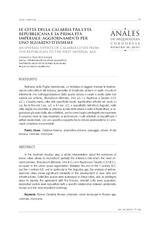Mostrar el registro sencillo del ítem
Le città della Calabria tra l’età repubblicana e la prima età imperiale: aggiornamenti per uno sguardo d’insieme
| dc.contributor.author | Mastrocinque, Gianluca | |
| dc.date.accessioned | 2020-02-12T09:25:26Z | |
| dc.date.available | 2020-02-12T09:25:26Z | |
| dc.date.issued | 2019 | |
| dc.identifier.issn | 1130-9741 | |
| dc.identifier.uri | http://hdl.handle.net/10396/19540 | |
| dc.description.abstract | Nell’area della Puglia meridionale, un tentativo di leggere insieme le testimonianze sulle città di età romana, permette di ricostruire, almeno in parte, il ruolo di riferimento che nell’organizzazione dello spazio urbano e rurale è svolto dalle due colonie più antiche, Brundisium (Brindisi, 244 a.C.) e Neptunia a Taranto (123 a.C.). L’analisi rivela, oltre alle specificità locali, significative affinità nel modo in cui, tra la fine del I sec. a.C. e il I sec. d.C. e soprattutto nell’età di Augusto, nelle città meglio documentate si potenzia la rete delle strade e delle infrastrutture, si organizzano gli spazi della vita collettiva, anche come luoghi privilegiati per esprimere il consenso verso la casa imperiale, si promuovono i culti orientali, si riqualificano i settori residenziali, con uno specifico rapporto tra le dimore aristocratiche e i principali complessi monumentali. | es_ES |
| dc.description.abstract | In the Southern Apulian area, a whole interpretation about the evidences of roman cities allows to reconstruct partially the reference role which the most ancient colonies, Brundisium (Brindisi, 244 B.C.) and Neptunia in Taranto (123 B.C.), occupied in the urban space organization. Between the end of the I century B.C. and the I century A.D. and in particular in the Augustus age, the analysis of well-researched cities shows significant similarity in the development of road nets and infrastructures. Collective spaces were rearranged in these cities, also as privileged areas to express the agreement with the Empire, oriental cults were supported, residential sectors were requalified with a specific relationship between aristocratic houses and the most important buildings. | es_ES |
| dc.format.mimetype | application/pdf | es_ES |
| dc.language.iso | ita | es_ES |
| dc.publisher | Universidad de Córdoba, Área de Arqueología | es_ES |
| dc.rights | https://creativecommons.org/licenses/by/3.0/ | es_ES |
| dc.source | Anales de Arqueología Cordobesa 30, 77-104 (2019) | es_ES |
| dc.subject | Calabria romana | es_ES |
| dc.subject | Urbanistica romana | es_ES |
| dc.subject | Paesaggio urbano di età romana | es_ES |
| dc.subject | Coloniae | es_ES |
| dc.subject | Municipia | es_ES |
| dc.subject | Roman Calabria | es_ES |
| dc.subject | Roman urbanism | es_ES |
| dc.subject | Urban landscape in Roman age | es_ES |
| dc.title | Le città della Calabria tra l’età repubblicana e la prima età imperiale: aggiornamenti per uno sguardo d’insieme | es_ES |
| dc.title.alternative | An overall update of Calabria cities from the republican to the first imperial age | es_ES |
| dc.type | info:eu-repo/semantics/article | es_ES |
| dc.relation.publisherversion | https://www.uco.es/ucopress/ojs/index.php/anarcor/index | es_ES |
| dc.rights.accessRights | info:eu-repo/semantics/openAccess | es_ES |

